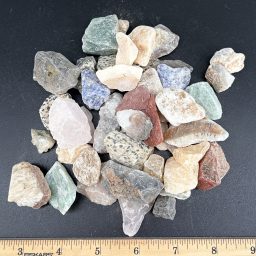Description
Sodalite is a felspathoidal tectosilicate mineral that is rich royal blue widely used as an ornamental gemstone. Chemical formula is Na8 (Al6Si6O24) Cl2. Specimens can be blue, gray, pink, colorless, or other pale shades. They sometimes fluoresce bright orange under ultraviolet light. Sodalite nearly always forms massive aggregates or disseminated grains. Crystals are relatively rare; when found, they are dodecahedral or octahedral. Sodalite occurs in igneous rocks and associated pegmatites. It is sometimes found in contact metamorphosed limestones and dolomites and in rocks ejected from volcanoes. Rare crystals are found on the Mount Vesuvius volcano in Italy. Uncommon transparent specimens from Mont St.-Hilaire, Canada, are faceted for collectors. Although massive sodalite samples are opaque, crystals are usually transparent to translucent. Sodalite is a member of the sodalite group with hauyne, nosean, lazurite and tugtupite.
Diagnostic Features: Distinguished in most instances by its blue color and told from lazurite by the absence of associated pyrite. It is very similar to Lapis but without the Pyrite If the color is not blue, a positive test for chlorine is the only way to distinguish it from analcime, leucite, and hauynite.









